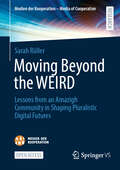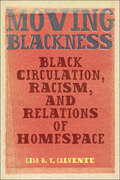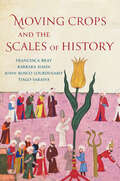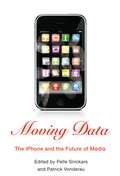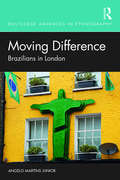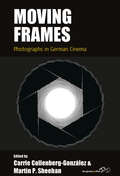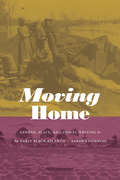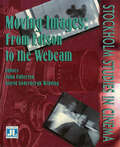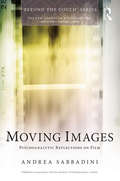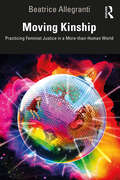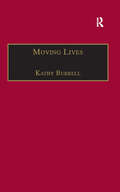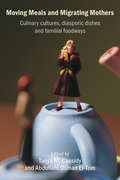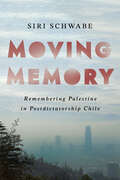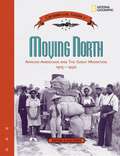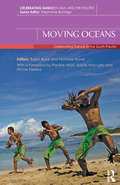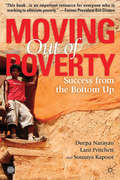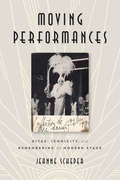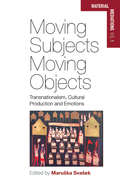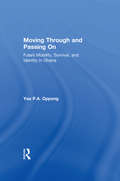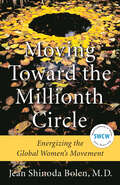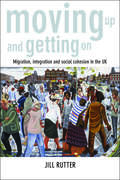- Table View
- List View
Moving Beyond the WEIRD: Lessons from an Amazigh Community in Shaping Pluralistic Digital Futures (Medien der Kooperation – Media of Cooperation)
by Sarah RüllerIn this open-access book, Sarah Rüller offers a comprehensive exploration of the complexities and nuances of conducting Western digital research in non-Western contexts, focusing on a case study in the High Atlas Mountains of Morocco. The research underscores the importance of addressing the challenges inherent in navigating this intercultural landscape, particularly as Western researchers immersed in ethnographic work. The studies highlight the multifaceted issues surrounding postcolonial frameworks, extractivism, technocapitalism, exploitation, and the evolving paradigms of development and sustainability, and underscores the urgent need for a more pluralistic, site-specific co-design approach. This approach is central to promoting inclusive and just digital futures, mitigating the impact of WEIRD (Western, Educated, Industrialized, Rich, and Democratic) biases, and unraveling the complex interplay of local and rural contexts torn between authenticity and exploitation by information and communication technologies (ICTs). This research delves deeper into a critical analysis of the establishment of a MediaSpace and the different community perspectives on technology access, revealing tensions and contradictions that shape the discourse on development and self-determination.
Moving Blackness: Black Circulation, Racism, and Relations of Homespace
by Lisa B. CalventeMoving Blackness: Black Circulation, Racism, and Relations of Homespace delves into the intricate connections between communication, culture, power, and racism in relation to blackness. Through a blend of interviews, oral histories, and meticulous archival research, this book sheds light on the multifaceted narratives surrounding Black identity. It explores how these stories circulate, serving as tools of resistance, negotiation, and affirmation of diverse manifestations and representations of blackness. By emphasizing the significance of storytelling as a means through which blackness affirms itself, transcending time and space, the book underscores how communicative embodiments of Black identity enable individuals to persevere within marginalized contexts. Engaging with theories of anti-Black racism, modernity, coloniality, and the Black diaspora, the book frames storytelling and the circulation of narratives as performances deeply rooted in the everyday lives of Black people across the diaspora. Starting with an examination of the racial construction of movement during colonialism and slavery, the book traces how this history shapes contemporary interactions. With its exploration of how Black circulation transforms movement and space, the book introduces a forward-thinking approach to the Black diaspora, anchored in a politics of identification rather than being confined to the past or a specific location. Moving Blackness argues that the desire for homespace, a yearning for belonging that transcends any particular physical space, fuels this envisioned future, rooted in the historical and material conditions of racism and marginalization.
Moving Crops and the Scales of History (Yale Agrarian Studies Series)
by Francesca Bray Barbara Hahn John Bosco LourdusamyA bold redefinition of historical inquiry based on the “cropscape”—the people, creatures, technologies, ideas, and places that surround a crop Human efforts to move crops from one place to another have been a key driving force in history. Crops have been on the move for millennia, from wildlands into fields, from wetlands to dry zones, from one imperial colony to another. This book is a bold but approachable attempt to redefine historical inquiry based on the “cropscape”: the assemblage of people, places, creatures, technologies, and other elements that form around a crop. The cropscape is a method of reconnecting the global with the local, the longue durée with microhistory, and people, plants, and places with abstract concepts such as tastes, ideas, skills, politics, and economic forces. Through investigating a range of contrasting cropscapes spanning millennia and the globe, the authors break open traditional historical structures of period, geography, and direction to glean insight into previously invisible actors and forces.
Moving Data: The iPhone and the Future of Media
by Pelle Snickars Patrick VonderauSmall farmers are often viewed as engaging in wasteful practices that wreak ecological havoc. Exploring Agrodiversity sets the record straight: Small farmers are in fact ingenious and inventive and engage in a diverse range of land-management strategies, many of them resourcefully geared toward conserving resources, especially soil. Using case studies from Africa, Asia, Latin America, and the Pacific, this book provides in-depth analysis of agricultural diversity and explores its history.
Moving Data: The iPhone and the Future of Media
by Pelle Snickars Patrick VonderauThe iPhone has revolutionized not only how people communicate but also how we consume and produce culture. Combining traditional and social media with mobile connectivity, smartphones have redefined and expanded the dimensions of everyday life, allowing individuals to personalize media as they move and process constant flows of data. Today, millions of consumers love and live by their iPhones, but what are the implications of its special technology on society, media, and culture?Featuring an eclectic mix of original essays, Moving Data explores the iPhone as technological prototype, lifestyle gadget, and platform for media creativity. Media experts, cultural critics, and scholars consider the device's newness and usability—even its "lickability"—and its "biographical" story. The book illuminates patterns of consumption; the fate of solitude against smartphone ubiquity; the economy of the App Store and its perceived "crisis of choice"; and the distance between the accessibility of digital information and the protocols governing its use. Alternating between critical and conceptual analyses, essays link the design of participatory media to the iPhone's technological features and sharing routines, and they follow the extent to which the pleasures of gesture-based interfaces are redefining media use and sensory experience. They also consider how user-led innovations, collaborative mapping, and creative empowerment are understood and reconciled through changes in mobile surveillance, personal rights, and prescriptive social software. Presenting a range of perspectives and arguments, this book reorients the practice and study of media critique.
Moving Difference: Brazilians in London (Routledge Advances in Ethnography)
by Angelo Martins JuniorMoving Difference demonstrates how differences between migrants who share the same nationality travel with them and can impact on every aspect of their ‘mobile lives’. Analysing the lived experiences and narratives of Brazilians in London, it adds an in-depth ethnographic understanding of the specific contours of difference to studies of migration by demonstrating how social differences, rooted in colonial legacies, are constantly being re-created and negotiated in the everyday making of the global world. By using ethnographic observations and in-depth interviews, in addition to historical and contextual analyses, the book allows us to understand how people speak of, engage with and negotiate difference in their everyday lives and how this is shaped by the macro-political and -social contexts of immigration and emigration. Giving attention to the complex interrelations between ‘here’ and ‘there’, past and present, this book allows us to go beyond the proliferated homogenised stereotypes of ‘the migrant’ and ‘the migrant community’ often reproduced by academics as well as by the media and politicians, whether with a view to pathologising or romanticising the ‘migrant other’. This title will appeal to students, scholars, community workers and general readers interested in migration, social class, gender, ‘race’ and ethnicity, colonialism and slavery, social exclusion, globalisation and urban sociology.
Moving Frames: Photographs in German Cinema (Film Europa #26)
by Carrie Collenberg-González Martin P. SheehanAs the building blocks of moving pictures, photographs have played an integral role in cinema since the dawn of the medium—a relationship that has grown more complexly connected even as the underlying technologies continue to evolve. Moving Frames explores the use of photographs in German films from Expressionism to the Berlin School, addressing the formal and narrative roles that photographs play as well as the cultural and historical contexts out of which these films emerged. Looking beyond and within the canon, the editors gather stimulating new insights into the politics of surveillance, resistance, representation, and collective memory functioning through photographic rupture and affect in German cinema.
Moving Histories of Class and Community
by Ben Rogaly Becky TaylorA major new study of white working class Britain since 1930, that shows how meanings of poverty have changed over time and how individuals reject categorization by the state. This book challenges accepted wisdom on the white working class, providing new understandings of community, place and class, arguing for the importance of migration.
Moving Home: Gender, Place, and Travel Writing in the Early Black Atlantic (Next Wave: New Directions in Women's Studies)
by Sandra GunningIn Moving Home, Sandra Gunning examines nineteenth-century African diasporic travel writing to expand and complicate understandings of the Black Atlantic. Gunning draws on the writing of missionaries, abolitionists, entrepreneurs, and explorers whose work challenges the assumptions that travel writing is primarily associated with leisure or scientific research. For instance, Yoruba ex-slave turned Anglican bishop Samuel Ajayi Crowther played a role in the Christianization of colonial Nigeria. Sarah Forbes Bonetta, a formerly enslaved girl "gifted" to Queen Victoria, traveled the African colonies as the wife of a prominent colonial figure and under the protection of her benefactress. Alongside Nancy Gardiner Prince, Martin R. Delany, Robert Campbell, and others, these writers used their mobility as African diasporic and colonial subjects to explore the Atlantic world and beyond while they negotiated the complex intersections between nation and empire. Rather than categorizing them as merely precursors of Pan-Africanist traditions, Gunning traces their successes and frustrations to capture a sense of the historical and geographical specificities that shaped their careers.
Moving Images: From Edison to the Webcam (Stockholm Studies in Cinema)
by John Fullerton, Astrid Söderbergh WiddingSeventeen essays examining the impact of new media on the history of cinema.In 1888, Thomas Edison announced that he was experimenting on “an instrument which does for the eye what the phonograph does for the ear, which is the recording and reproduction of things in motion.” Just as Edison’s investigations were framed in terms of the known technologies of the phonograph and the microscope, the essays in this collection address the contexts of innovation and reception that have framed the development of moving images in the last one hundred years. Three concerns are of particular interest: the contexts of innovation and reception for moving image technologies; the role of the observer, whose vision and cognitive processes define some of the limits of inquiry and epistemological insight; and the role of new media, which, engaging with the domestic sphere as cultural interface, are transforming our understanding of public and private spheres.The seventeen previously unpublished essays in Moving Images represent the best of current research in the history of this field. They make a timely and stimulating contribution to debates concerning the impact of new media on the history of cinema.Contributors include: William Boddy, Carlos Bustamante, Warren Buckland, Valeria Camporesi, Bent Fausing, Oliver Gaycken, Alison Griffiths, Christopher Hales, Jan Holmberg, Solveig Jülich, Frank Kessler, Jay Moman, Sheila C. Murphy, Pelle Snickars, Paul C. Spehr, Björn Thuresson, and Åke Walldius.
Moving Images: Psychoanalytic reflections on film (The New Library of Psychoanalysis 'Beyond the Couch' Series)
by Andrea SabbadiniThe experience of watching films – entertaining, moving, instructive, frightening or exciting as they may be – can be enriched by the opportunity to reflect upon them from unconventional perspectives.Psychoanalytic Reflections on Film: Moving Images offers its readers in an accessible language one such viewpoint, informed by Andrea Sabbadini's psychoanalytic insights and therapeutic experience. Using a psychoanalytic interpretative approach, some twenty-five important feature films are discussed as the artistic vehicles of new, unsuspected meanings. The first chapter looks at films which represent psychoanalytic work itself, having therapists and their patients as their main characters. The remaining five chapters cover movies on themes of central concern to analytic theorists and clinicians, such as childhood and adolescent development, and varieties of intimate relationships among adults. The latter include romantic love and its disturbing association to death fantasies; eroticism and prostitution; and voyeuristic desire – a significant phenomenon in this context given its parallels with the activity of watching films. Andrea Sabbadini's psychoanalytic approach, which explores the part played by unconscious factors in shaping the personality and behaviour of film characters, is used to interpret their internal world and the emotional conflicts engendered by the vicissitudes they live through. The book is completed by a filmography and biographical notes on film directors. Psychoanalytic Reflections on Film presents the relationship between cinema and psychoanalysis as a complex one. These two most different of cultural phenomena are shown to share a wish on the part of their practitioners to uncover profound truths about the human condition, and to provide a language with which to describe them. Going beyond futile ‘psycho-historical’ attempts to analyse filmmakers through their products, or a superficial application of psychoanalytic concepts to film, Sabbadini shows how both cinema and psychoanalysis can benefit from a meaningful interdisciplinary dialogue between them. The book will be of special interest to practicing psychoanalysts and students, scholars and historians of film studies.
Moving Kinship: Practicing Feminist Justice in a More-than-Human World
by Beatrice AllegrantiIn this compelling text, choreographer and psychotherapist Beatrice Allegranti invites the reader into the transdisciplinary Moving Kinship project. Moving Kinship spans a decade of practice-led research with people experiencing early onset dementia; Black feminist activists; psychotherapists; lesbian, gay, bisexual, transgender and queer artists and activists; capoeiristas; and an international team of professional dancers and composers, musicians and scientists.Allegranti’s practice is a more-than-collaboration: it involves accounting for deeply embodied and embedded oppression and privilege in the micro-relating of everyday life. She discusses this reckoning as a kin-aesthetic practice, and the message is foundationally feminist. The book opens possibilities for different registers of feminist justice and puts feminist new materialism, posthumanism and intersectional body politics to work in ways that affirm the paradox that every living thing moves everywhere, all the time, yet every movement is never neutral. As a white Italian-Irish feminist with a transgenerational legacy of the corrosive impact of fascism, she also weaves her own kinship story into dominating systems of patriarchy, colonialism and capitalism, intersecting in ways that are alive and well today.Moving Kinship offers a rich resource for feminist activists and scholars, trauma-informed therapists, somatic, movement and dance practitioners, artists and those interested in ethical and politically just ways to materially engage with grief, loss, dispossession and trauma.
Moving Lives: Narratives of Nation and Migration among Europeans in Post-War Britain (Research in Migration and Ethnic Relations Series)
by Kathy BurrellImmigrants in Britain are often viewed as just that - 'immigrants'. Their experiences as migrants are sidelined in favour of discussions about assimilation and integration - how 'they' adapt to 'us'. This book refocuses debates about migration by following the experiences, memories and perceptions of three migrant groups in Britain: the Polish, Italian and Greek-Cypriot populations. In tracing some of the key themes of migration narratives, Kathy Burrell illustrates that the act of migration creates enduring legacies which continue to influence the everyday lives of migrants long after they have moved. The book is structured around four key themes. The first is the migration process itself. Burrell highlights the important contrast between voluntary and involuntary migration, examining the different memories and legacies of migration. The second theme is the national, (as opposed to ethnic) identities of the groups studied. The author demonstrates how national consciousness survives the upheaval of migration and is perpetuated through the recognition of national histories, myths and traditional rituals. The third theme is a memory of the homeland. The author traces her respondents' memories and experiences of their national territory, focusing particularly on the transnational connections that are established with the homeland after migration. Finally Burrell considers community, analyzing her respondents' experiences of community life and the shared social and cultural norms and values that underpin it.
Moving Matters: Paths of Serial Migration
by Susan OssmanMoving Mattersis a richly nuanced portrait of the serial migrant: a person who has lived in several countries, calling each one at some point "home. " The stories told here are both extraordinary and increasingly common. Serial migrants rarely travel freely—they must negotiate a world of territorial borders and legal restrictions—yet as they move from one country to another, they can use border-crossings as moments of self-clarification. They often become masters of settlement as they turn each country into a life chapter. Susan Ossman follows this diverse and growing population not only to understand how paths of serial movement produce certain ways of life, but also to illuminate an ongoing tension between global fluidity and the power of nation-states. Ultimately, her lyrical reflection on migration and social diversity offers an illustration of how taking mobility as a starting point fundamentally alters our understanding of subjectivity, politics, and social life.
Moving Meals and Migrating Mothers: Culinary cultures, diasporic dishes and familial foodways
by Tanya M. Cassidy;Abdullahi Osman El-TomMoving Meals and Migrating Mothers: Culinary cultures, diasporic dishes and familial foodways explores the complex interplay between the important global issues of food, families, and migration. We have an introduction and twelve additional chapters which we have organised into three parts: Part I Moving Meals, Markets and Migrant Mothers; Part II Migrating Mothers Performing Identity through Moving Meals; Part III Meanings and Experiences of Migrant Maternal Meals. Although these parts are not mutually exclusive, they are meant to emphasize socio-cultural and economic considerations of migration (Part I), the food itself (Part II), and families (Part III). We have a wide geographic representation, including Europe (Ireland and France), the USA, Canada, New Zealand, and Korea. In addition, we have contributors from all stages of career, including full professors, as well recent doctoral graduates. Overall the contributions are interdisciplinary, and therefore use a variety of methodologies, although most make use of traditional social sciences methods, including interviews and ethnographic observations.
Moving Memory: Remembering Palestine in Postdictatorship Chile
by Siri SchwabeMoving Memory is an ethnography of remembrance in the field of tension between post-dictatorship Chile and occupied Palestine that offers new insights into memory politics as a globally resurgent and increasingly transnational phenomenon. It tells a largely untold story of a Palestinian diaspora: how a predominantly Christian, conservative, and wealthy elite has come to form the backbone of a diasporic community to which the Palestinian struggle remains a central mobilizing force. Schwabe explores how Palestinian diaspora politics play into larger attempts to obscure the recent Chilean past and its consequences, all the while working to counter Zionist efforts to negate and erase Palestinian existence. Despite considerable efforts to contain them, memories move. They travel across porous and ever-changing geographical and socio-political boundaries, reconfiguring realities in the process. In exploring the paradoxes of remembering and forgetting between Palestine and Chile as intertwining nodes in the complex field of global memory politics, the book demarcates the limits and possibilities of forging solidarity at the fault lines of memory.
Moving North: African Americans and the Great Migration 1915-1930 (Crossroads America )
by Monica HalpernAfter the Civil War, the South went through a period of rebuilding, termed Recon-struction, but because many white people in the South were not ready to accept African Americans as equals, unfair laws were passed which restricted the rights of blacks. These Black Codes and Jim Crow laws left African Americans adrift in a segregated world. <P><P>Life was better in the North in many ways for African Americans. The 1920s brought jobs and money—until The Great Depression hit. The Depression left many homeless and jobless. Many blacks left the cities seeking jobs wherever they could find them. Despite the hard times that followed, living in the North continued to bring a renewed sense of freedom to many African Americans.
Moving Oceans: Celebrating Dance in the South Pacific (Celebrating Dance in Asia and the Pacific)
by Nicholas Rowe Ralph BuckCelebrating the diversity of dance across the South Pacific, this volume studies the various experiences, motivations and aims for dance, emerging from the voices of dance professionals in the islands. In particular, it focuses on the interplay of cultures and pathways of migration as people move across the region discovering new routes and connections.
Moving Out of Poverty: Success from the Bottom Up
by Deepa Narayan Soumya Kapoor Lant Pritchett'No matter if I fall, I get up again. If I fall 5,000 times, I will stand up another 5,000 times.' -- William, a 37-year-old from El Gorrión, Colombia. Why and how do some people move out of poverty--and stay out--while others remain trapped? Most books on growth and poverty reduction are dominated by the perspectives of policy makers and academic experts. In contrast, 'Moving Out of Poverty: Success from the Bottom Up' presents the experiences of poor people who have made it out of poverty. The book's findings draw from the Moving Out of Poverty research conducted in communities in 15 countries in Africa, East Asia, Latin America, and South Asia. The authors synthesize the results of qualitative and quantitative research based on discussions with over 60,000 people in rural areas. They offer bottom-up perspectives on the processes and local institutions that play key roles in escapes from poverty. The study finds that there are no differences in the initiatives taken by the poor, the rich, and the upwardly mobile. What, then, explains the difference in outcomes? The authors demonstrate how-in the face of deep social inequalities that block access to economic opportunities and local democracies-individual initiative and empowerment by themselves are often not enough to escape poverty. This book will be of interest to all concerned with equity in an increasingly unequal world.
Moving Performances: Divas, Iconicity, and Remembering the Modern Stage
by Jeanne ScheperFabulous yet fierce, imperious yet impetuous, boss yet bitchy—divas are figures of paradox. Their place in culture is equally contradictory, as they are simultaneously venerated and marginalized, hailed as timeless but then frequently forgotten or exhumed as cult icons by future generations. Focusing on four early twentieth-century divas—Aida Overton Walker, Loïe Fuller, Libby Holman, and Josephine Baker—who were icons in their own time, Moving Performances considers what their past and current reception reveals about changing ideas of race and gender. Jeanne Scheper examines how iconicity can actually work to the diva’s detriment, reducing her to a fetish object, a grotesque, or a figure of nostalgia. Yet she also locates more productive modes of reception that reach to revive the diva’s moving performances, imbuing her with an affective afterlife. As it offers innovative theorizations of performance, reception, and affect, Moving Performances also introduces readers to four remarkable women who worked as both cultural producers and critics, deftly subverting the tropes of exoticism, orientalism, and primitivism commonly used to dismiss women of color. Rejecting iconic depictions of these divas as frozen in a past moment, Scheper vividly demonstrates how their performances continue to inspire ongoing movements.
Moving Politics: Emotion and ACT UP's Fight Against AIDS
by Deborah B. GouldIn the late 1980s, after a decade spent engaged in more routine interest-group politics, thousands of lesbians and gay men responded to the AIDS crisis by defiantly and dramatically taking to the streets. But by the early 1990s, the organization they founded, ACT UP, was no more--even as the AIDS epidemic raged on. Weaving together interviews with activists, extensive research, and reflections on the author's time as a member of the organization, Moving Politics is the first book to chronicle the rise and fall of ACT UP, highlighting a key factor in its trajectory: emotion. Surprisingly overlooked by many scholars of social movements, emotion, Gould argues, plays a fundamental role in political activism. From anger to hope, pride to shame, and solidarity to despair, feelings played a significant part in ACT UP's provocative style of protest, which included raucous demonstrations, die-ins, and other kinds of street theater. Detailing the movement's public triumphs and private setbacks, Moving Politics is the definitive account of ACT UP's origin, development, and decline as well as a searching look at the role of emotion in contentious politics.
Moving Subjects, Moving Objects
by Maruška SvašekIn recent years an increasing number of scholars have incorporated a focus on emotions in their theories of material culture, transnationalism and globalization, and this book aims to contribute to this field of inquiry. It examines how 'emotions' can be theorized, and serves as a useful analytical tool for understanding the interrelated mobility of humans, objects and images. Ethnographically rich, and theoretically grounded case studies offer new perspectives on the relations between migration, material culture and emotions. While some chapters address the many different ways in which migrants and migrant artists express their emotions through objects and images in transnational contexts, other chapters focus on how particular works of art, everyday objects and artefacts can evoke feelings specific to particular migrant groups and communities. Case studies also analyse how artists, academics and policy makers can stimulate positive interaction between migrants and non-migrant communities.
Moving Through and Passing On: Fulani Mobility, Survival and Identity in Ghana
by Yaa P.A. Oppong"The Fulani are one of West Africa's most populous and geographically dispersed ethnic groups. Commonly thought of as a pastoral people, primarily engaged in cattle herding, Fulani peoples are in reality highly differentiated in livelihood and patterns of mobility. Despite having a long history of residence in Ghana, Fulani are considered ""aliens"" in the eyes of the state and ""strangers"" by the various ethnic groups among whom they reside. Among Fulani themselves, differences of place, circumstance, and experience have generated parallel ambigoities on matters of identity and survival. In Moving Through and Passing On, Yaa P.A. Oppong focuses on the Fulani of the Greater Accra region to offer the first detailed account of the lives of this transnational community in Ghana.Based on eighteen months of ethnographic fieldwork, Oppong develops detailed case studies and draws upon over two hundred in-depth life histories to explore issues of mobility, survival, and identity among this spacially dispersed and diverse group. Using perspectives and insights gained from oral life histories, private and public ceremonies, and ethnic associations, she examines the sites and circumstances in which people profess to be the ""same"" or ""different"" from one another. The markers of Fulani identity-as recognized by Fulani and non-Fulani alike-are examined. Oppong also explores the factors that allow them, as a distinct ethnic category, to maintain and perpetuate this identity and viability in Greater Accra. The metaphoric analogy of ""construction sites"" is employed to define the explicit and implicit events and recurring processes through which people conceive of themselves as Fulani. These locations and contexts of action include ethnic associations, public gatherings, and common rites of passage. The recurring processes include genealogical reckoning of kinship and endogamous marriage transactions, and the ways in which ties of descent and filiation are used to enha"
Moving Toward the Millionth Circle: Energizing the Global Women's Movement
by Jean Shinoda Bolen“Describes how every woman can be supported by a circle of friends with a sacred center, and how circles multiply their spiritual and political energy.” —Isabel AllendeWhile women’s individual experiences and stories differ, there remains to be a uniting factor that draws women from around the world together. In this book for women, author Jean Shinoda Bolen calls upon this uniting factor, this feminine spirit ingrained in the soul of each woman, as a source of motivation for activism. As a result, this activism focused on women empowerment is person-focused and heart-centered.Each of us wields the power to make change. By channeling our passions into all that we do, our voices and our actions, we take this world one step closer to being a better home for all who live in it. But joining with others is key to this effort. Bolen emphasizes the importance of relying on a support system, particularly women’s circles, in order to grow in influence.The metaphoric millionth circle is the tipping point into a post-patriarchal era. It is through the process of a growing number of people changing their perceptions and behaviors that a new era will begin. Those in the circles feed the activism by strengthening each other, and in turn, the movement as a whole. This spiritual book for women serves as a practical and poetic call to action, inspiring women and others to follow a path with soul.In Moving Toward the Millionth Circle you’ll discover . . .A deeper dive into The Millionth Circle InitiativeWords of passionate wisdom from an internationally known author and speakerA rallying cry for all women seeking change
Moving Up and Getting On: Migration, Integration and Social Cohesion in the UK
by Jill RutterIn most developed countries immigration policy is high on the political agenda. But what happens to migrants after their arrival – integration and social cohesion – has received less attention, yet these conditions matter to migrants and to wider society. Drawing on fieldwork in London and eastern England, Moving up and getting on is the first accessible, yet comprehensive, text to critique the effectiveness of recent integration and social cohesion policies and calls for a stronger political leadership. Written for those interested in public policy, the book argues that if the UK is to be successful in managing migration, there needs to be greater emphasis on the social aspects of integration and opportunities for meaningful social contact between migrants and longer-settled residents, particularly in the workplace.
